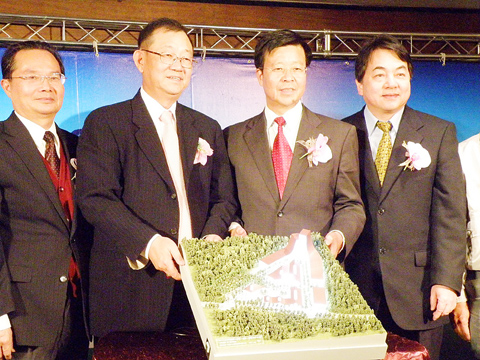Taiwan Land Development Corp (台灣土地開發公司) yesterday signed a 50-year build-operate-transfer (BOT) agreement with the Kinmen County Government, promising to turn the former war-torn island into an international tourism and leisure spot in five years with an initial budget of NT$3.69 billion (US$113.3 million).
“We hope that when the project is completed, it will bring in tens of billions [of New Taiwan dollars] in economic benefits to Kinmen,” Kinmen County Commissioner Lee Chu-feng (李炷烽) told a signing ceremony.
The project will create 1,500 job opportunities, more than 60 percent of which will be reserved for local residents, he said.

PHOTO: WANG LIANG-YUN, TAIPEI TIMES
That excludes workers that will be employed during the project’s construction, the land developer said.
The BOT project covers a 7.45 hectare lot 200m north of Kinmen Shanyi Airport, where a hotel, exhibition and conference halls, bonded warehouses, recreation and shopping malls, as well as a duty-free shop will be built starting next year and completed in three to five years.
Taiwan Land Development chairman Chiu Fu-sheng (邱復生) said the entire project could cost up to NT$10 billion, 50 percent of which would come from company funds and the remaining 50 percent would be raised from investors at home and abroad.
Chiu said institutional investors or property developers in Hong Kong, China and the US had expressed interest in taking part in the project. He did not elaborate, citing confidentiality.
Seven retailers, including duty-free Ever Rich DFS Corp (昇恆昌), Hsin Tung Yang Co (新東陽) and local specialty shops such as Sheng Zu Food and Beverage Corp (聖祖食品) and knife manufacturer Master Wu Co (金合利鋼刀), have agreed to set up outlets in the leisure district there, the developer said.
Taiwan Land Development president Andy Lai (賴昭輝) said that the soon-to-be-built hotel would be a three or five-star establishment with 300 to 500 rooms.
He estimated that the 50-year project could contribute a minimum of NT$2.4 billion in tax revenue to the county government, while potential tourism revenue could reach at least NT$2 billion per year.
If the estimated 1.7 million visitors traveling via the “small three links” — with the number forecast to rise to 2 million in two years — were to spend NT$1,000 each, the county government could get a revenue boost of NT$2 billion per year, he said.
Moreover, if 1 percent to 10 percent of 21 million tourists traveling to Xiamen, China, could extend their trip to include Kinmen at a cost of NT$10,000, the county government could further see an income of between NT$2.1 billion to NT$21 billion each year, he added.
Lee said Kinmen now attracts about 500,000 tourists per year, including 150,000 Chinese tourists since late last year, including 50,000 who stayed overnight.
High-quality kaoliang liquor, which is sold for 300 yuan (US$44) in Kinmen and 1,188 yuan in China, is popular among Chinese tourists.

Shares in Taiwan closed at a new high yesterday, the first trading day of the new year, as contract chipmaker Taiwan Semiconductor Manufacturing Co (TSMC, 台積電) continued to break records amid an artificial intelligence (AI) boom, dealers said. The TAIEX closed up 386.21 points, or 1.33 percent, at 29,349.81, with turnover totaling NT$648.844 billion (US$20.65 billion). “Judging from a stronger Taiwan dollar against the US dollar, I think foreign institutional investors returned from the holidays and brought funds into the local market,” Concord Securities Co (康和證券) analyst Kerry Huang (黃志祺) said. “Foreign investors just rebuilt their positions with TSMC as their top target,

REVENUE PERFORMANCE: Cloud and network products, and electronic components saw strong increases, while smart consumer electronics and computing products fell Hon Hai Precision Industry Co (鴻海精密) yesterday posted 26.51 percent quarterly growth in revenue for last quarter to NT$2.6 trillion (US$82.44 billion), the strongest on record for the period and above expectations, but the company forecast a slight revenue dip this quarter due to seasonal factors. On an annual basis, revenue last quarter grew 22.07 percent, the company said. Analysts on average estimated about NT$2.4 trillion increase. Hon Hai, which assembles servers for Nvidia Corp and iPhones for Apple Inc, is expanding its capacity in the US, adding artificial intelligence (AI) server production in Wisconsin and Texas, where it operates established campuses. This

H200 CHIPS: A source said that Nvidia has asked the Taiwanese company to begin production of additional chips and work is expected to start in the second quarter Nvidia Corp is scrambling to meet demand for its H200 artificial intelligence (AI) chips from Chinese technology companies and has approached contract manufacturer Taiwan Semiconductor Manufacturing Co (TSMC, 台積電) to ramp up production, sources said. Chinese technology companies have placed orders for more than 2 million H200 chips for this year, while Nvidia holds just 700,000 units in stock, two of the people said. The exact additional volume Nvidia intends to order from TSMC remains unclear, they said. A third source said that Nvidia has asked TSMC to begin production of the additional chips and work is expected to start in the second

US President Donald Trump on Friday blocked US photonics firm HieFo Corp’s US$3 million acquisition of assets in New Jersey-based aerospace and defense specialist Emcore Corp, citing national security and China-related concerns. In an order released by the White House, Trump said HieFo was “controlled by a citizen of the People’s Republic of China” and that its 2024 acquisition of Emcore’s businesses led the US president to believe that it might “take action that threatens to impair the national security of the United States.” The order did not name the person or detail Trump’s concerns. “The Transaction is hereby prohibited,”